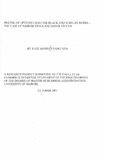| dc.description.abstract | The objectives of this research were, first , to determine the level of stock
volatility, for the period 1997 to 2000, on the Nairobi Stock Exchange and
identify securities that warrant hedging through the use of options. Having assessed
the volatilities, the second objective was to determine the range of exercise prices,
for individual stocks, that would generate in-the-money European options. Thirdly,
the research sought to determine whether the world re-known Black and Scholes
option pricing model could be used to value options on stocks quoted on the
Nairobi Stock Exchange.
The level of stock volatility on the Nairobi Stock Exchange was determined using
the expected returns and monthly share price movements for each stock. Exercise
price ranges were determined using a mathematical model described in detail in
the research paper. Having collated all the data required to use the Black and
Scholes model, option values were determined using a Black and Scholes
computation software, derivagem.
The expected returns for stocks in the four years under review were markedly
poor, which is perhaps expected, in view of the downturn in the Kenyan economy
in the said period, mirrored in the performance of the Exchange. Stock volatilities
- were significant for all stocks on the Exchange with the exception of Kapchorua
Tea Company, Limuru Tea Company and Regent Undervalued Assets Africa Fund.
The latter did not trade while for Kapchorua Tea Company and Limuru Tea
Company, monthly share prices remained virtually the same during the period of
study.
The mathematically determined exercise price ranges were fairly reasonable in
Views of the fact that they fell within actual share price movements in the periods
under review and were in tandem with the individual volatilities of the stocks,
that is the higher the volatility, the wider the range of mathematically derived
exercise ranges and vice versa. The research indicates that the Black and Scholes
option pricing model can be used to determine option values and ranges for in-the
-money options for stocks quoted on the Nairobi Stock Exchange. All the data
required to use the model was based on secondary market data, with stock
volatility and exercise price ranges being determined mathematically using
historical data.
The study gives useful insight into the performance of the Exchange (in specific,
returns and volatilities of stocks quoted thereon) and offers to investors and fund
managers an alternative means of managing the risks of their quoted investments,
by hedging through the use of options. To the regulatory authority, the study
gives the practical ties of pricing options in a Kenyan context, which will be
crucial in order to effectively establish the options exchange (fourth segment) in
Kenya. Being a pioneer study in option pricing, the study opens an avenue for
further extensive research by Kenya's academia. | en |

